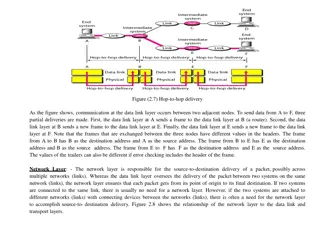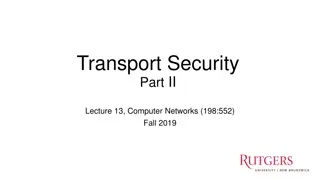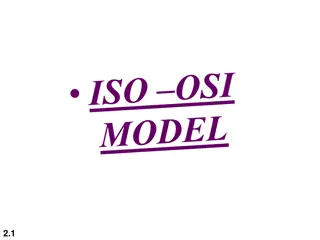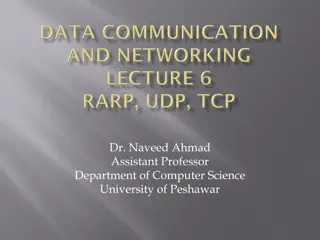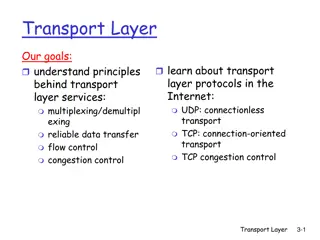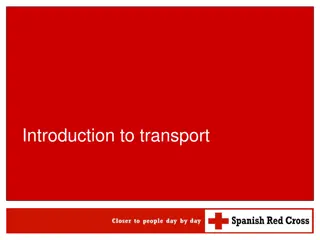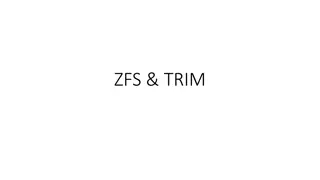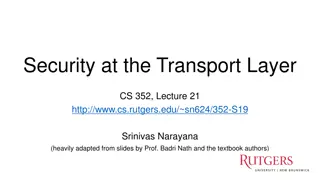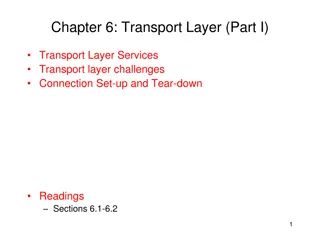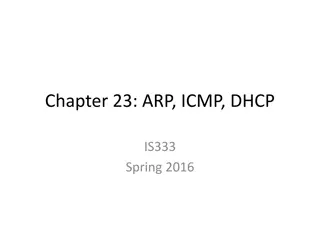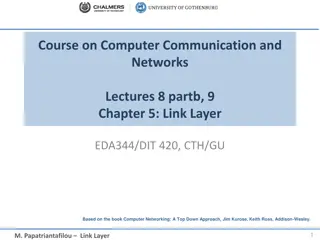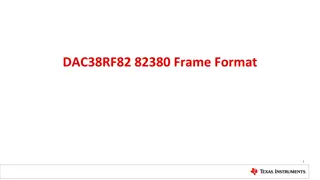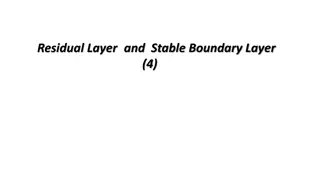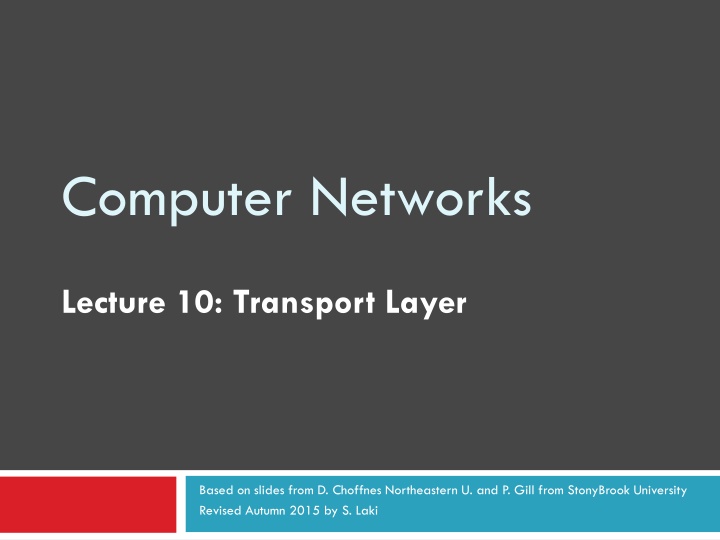
TCP in Computer Networks: Transport Layer Insights
Explore the concepts of Transmission Control Protocol (TCP) in computer networks, including TCP features, connection setup, three-way handshake, connection tear down, sequence number space, and bidirectional communication. Learn about TCP's reliability, flow control, congestion control, and more.
Download Presentation

Please find below an Image/Link to download the presentation.
The content on the website is provided AS IS for your information and personal use only. It may not be sold, licensed, or shared on other websites without obtaining consent from the author. If you encounter any issues during the download, it is possible that the publisher has removed the file from their server.
You are allowed to download the files provided on this website for personal or commercial use, subject to the condition that they are used lawfully. All files are the property of their respective owners.
The content on the website is provided AS IS for your information and personal use only. It may not be sold, licensed, or shared on other websites without obtaining consent from the author.
E N D
Presentation Transcript
Computer Networks Lecture 10: Transport Layer Based on slides from D. Choffnes Northeastern U. and P. Gill from StonyBrook University Revised Autumn 2015 by S. Laki
Outline 2 UDP already discussed TCP Congestion Control Evolution of TCP Problems with TCP
Transmission Control Protocol 3 Reliable, in-order, bi-directional byte streams Port numbers for demultiplexing Virtual circuits (connections) Flow control Congestion control, approximate fairness 0 Source Port Why these features? 4 16 31 Destination Port Sequence Number Acknowledgement Number Flags Checksum HLen Advertised Window Urgent Pointer Options
Connection Setup 4 Why do we need connection setup? To establish state on both hosts Most important state: sequence numbers Count the number of bytes that have been sent Initial value chosen at random Why? Important TCP flags (1 bit each) SYN synchronization, used for connection setup ACK acknowledge received data FIN finish, used to tear down connection
Three Way Handshake 5 Client Server Why Sequence # +1? Each side: Notifies the other of starting sequence number ACKs the other side s starting sequence number
Connection Tear Down 7 Either side can initiate tear down Other side may continue sending data Half open connection shutdown() Acknowledge the last FIN Sequence number + 1 What happens if 2nd FIN is lost? Client Server
Sequence Number Space 8 TCP uses a byte stream abstraction Each byte in each stream is numbered 32-bit value, wraps around Initial, random values selected during setup. Why? Byte stream broken down into segments (packets) Size limited by the Maximum Segment Size (MSS) Set to limit fragmentation Each segment has a sequence number 13450 14950 16050 17550 Segment 8 Segment 9 Segment 10
Bidirectional Communication 9 Client Server Seq. 1 Ack. 23 Seq. 23 Ack. 1 23 1461 1461 753 Data and ACK in the same packet 753 2921 Each side of the connection can send and receive Different sequence numbers for each direction
Flow Control 10 Problem: how many packets should a sender transmit? Too many packets may overwhelm the receiver Size of the receivers buffers may change over time Solution: sliding window Receiver tells the sender how big their buffer is Called the advertised window For window size n, sender may transmit n bytes without receiving an ACK After each ACK, the window slides forward Window may go to zero!
Flow Control: Sender Side 11 Packet Received Packet Sent Src. Port Dest. Port Src. Port Dest. Port Sequence Number Sequence Number Acknowledgement Number Flags Checksum Must be buffered until ACKed Acknowledgement Number Flags Checksum HL Window Urgent Pointer HL Window Urgent Pointer ACKed Sent To Be Sent Outside Window Window
Sliding Window Example 12 TCP is ACK Clocked Short RTT quick ACK window slides quickly Long RTT slow ACK window slides slowly Time Time
Observations 13 Throughput is ~ w/RTT Sender has to buffer all unacknowledges packets, because they may require retransmission Receiver may be able to accept out-of-order packets, but only up to buffer limits
What Should the Receiver ACK? 14 ACK every packet Use cumulative ACK, where an ACK for sequence n implies ACKS for all k < n Use negative ACKs (NACKs), indicating which packet did not arrive Use selective ACKs (SACKs), indicating those that did arrive, even if not in order SACK is an actual TCP extension 1. 2. 3. 4. 14
Sequence Numbers, Revisited 15 32 bits, unsigned Why so big? For the sliding window you need |Sequence # Space| > 2 * |Sending Window Size| 232 > 2 * 216 Guard against stray packets IP packets have a maximum segment lifetime (MSL) of 120 seconds i.e. a packet can linger in the network for 2 minutes
Silly Window Syndrome 16 Problem: what if the window size is very small? Multiple, small packets, headers dominate data Header Header Header Header Data Data Data Data Equivalent problem: sender transmits packets one byte at a time for (int x = 0; x < strlen(data); ++x) write(socket, data + x, 1); 1. 2.
Nagles Algorithm 17 If the window >= MSS and available data >= MSS: Send the data Elif there is unACKed data: Enqueue data in a buffer until an ACK is received Else: send the data 1. Send a full packet 2. Send a non-full packet if nothing else is happening 3. Problem: Nagle s Algorithm delays transmissions What if you need to send a packet immediately? int flag = 1; setsockopt(sock, IPPROTO_TCP, TCP_NODELAY, (char *) &flag, sizeof(int)); 1. 2.
Error Detection 18 Checksum detects (some) packet corruption Computed over IP header, TCP header, and data Sequence numbers catch sequence problems Duplicates are ignored Out-of-order packets are reordered or dropped Missing sequence numbers indicate lost packets Lost segments detected by sender Use timeout to detect missing ACKs Need to estimate RTT to calibrate the timeout Sender must keep copies of all data until ACK
Retransmission Time Outs (RTO) 19 Problem: time-out is linked to round trip time Timeout is too short RTO RTO What about if timeout is too long?
Round Trip Time Estimation 20 Sample Original TCP round-trip estimator RTT estimated as a moving average new_rtt = (old_rtt) + (1 )(new_sample) Recommended : 0.8-0.9 (0.875 for most TCPs) RTO = 2 * new_rtt (i.e. TCP is conservative)
RTT Sample Ambiguity 21 RTO RTO Sample? Sample Karn s algorithm: ignore samples for retransmitted segments
TCP Congestion Control 22 The network is congested if the load in the network is higher than its capacity. Each TCP connection has a window Controls the number of unACKed packets Sending rate is ~ window/RTT Idea: vary the window size to control the send rate Introduce a congestion window at the sender Congestion control is sender-side problem
Two Basic Components 23 Detect congestion Packet dropping is most reliably signal Delay-based methods are hard and risky How do you detect packet drops? ACKs Timeout after not receiving an ACK Several duplicate ACKs in a row (ignore for now) Rate adjustment algorithm Modify cwnd Probe for bandwidth Responding to congestion 1. 2.
Rate Adjustment 24 Recall: TCP is ACK clocked Congestion = delay = long wait between ACKs No congestion = low delay = ACKs arrive quickly Basic algorithm Upon receipt of ACK: increase cwnd Data was delivered, perhaps we can send faster cwnd growth is proportional to RTT On loss: decrease cwnd Data is being lost, there must be congestion Question: increase/decrease functions to use? !!!!
Implementing Congestion Control 25 Maintains three variables: cwnd: congestion window adv_wnd: receiver advertised window ssthresh: threshold size (used to update cwnd) For sending, use: wnd = min(cwnd, adv_wnd) Two phases of congestion control Slow start (cwnd < ssthresh) Probe for bottleneck bandwidth Congestion avoidance (cwnd >= ssthresh) AIMD 1. 2. 25
Slow Start 26 Goal: reach knee quickly Upon starting (or restarting) a connection cwnd =1 ssthresh = adv_wnd Each time a segment is ACKed, cwnd++ Continues until ssthresh is reached Or a packet is lost Knee Cliff Goodput Slow Start is not actually slow cwnd increases exponentially Load
Slow Start Example 27 cwnd = 1 cwnd grows rapidly Slows down when cwnd >= ssthresh Or a packet drops cwnd = 2 cwnd = 4 cwnd = 8
Congestion Avoidance 28 Additive Increase Multiplicative Decrease (AIMD) mode ssthresh is lower-bound guess about location of the knee Ifcwnd >= ssthresh then each time a segment is ACKed increment cwnd by 1/cwnd (cwnd += 1/cwnd). So cwnd is increased by one only if all segments have been acknowledged
Congestion Avoidance Example 29 cwnd = 1 cwnd = 2 cwnd >= ssthresh 14 cwnd = 4 cwnd (in segments) 12 10 ssthresh = 8 8 6 cwnd = 8 Slow Start 4 2 0 t=0 t=2 Round Trip Times t=4 t=6 cwnd = 9
The Big Picture TCP Tahoe (the original TCP) 30 ssthresh Timeout Congestion Avoidance cwnd Slow Start Time



